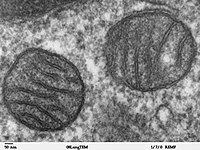
Photo from wikipedia
Nonalcoholic or metabolic associated fatty liver disease (NAFLD/MAFLD) is a hepatic reflection of metabolic derangements characterized by excess fat deposition in the hepatocytes. Identifying metabolic regulatory nodes in fatty liver… Click to show full abstract
Nonalcoholic or metabolic associated fatty liver disease (NAFLD/MAFLD) is a hepatic reflection of metabolic derangements characterized by excess fat deposition in the hepatocytes. Identifying metabolic regulatory nodes in fatty liver pathology is essential for effective drug targeting. Fatty liver is often associated with circadian rhythm disturbances accompanied with alterations in physical and feeding activities. In this regard, both sirtuins and clock machinery genes have emerged as critical metabolic regulators in maintaining liver homeostasis. Knockouts of either sirtuins or clock genes result in obesity associated with the fatty liver phenotype. Sirtuins (SIRT1‐SIRT7) are a highly conserved family of nicotinamide adenine dinucleotide (NAD+)‐dependent deacetylases, protecting cells from metabolic stress by deacetylating vital proteins associated with lipid metabolism. Circadian rhythm is orchestrated by oscillations in expression of master regulators (BMAL1 and CLOCK), which in turn regulate rhythmic expression of clock‐controlled genes involved in lipid metabolism. The circadian metabolite, NAD+ , serves as a crucial link connecting clock genes to sirtuin activity. This is because, NAMPT which is a rate limiting enzyme in NAD+ biosynthesis is transcriptionally regulated by the clock genes and NAD+ in turn is a cofactor regulating the deacetylation activity of sirtuins. Intriguingly, on one hand the core circadian clock regulates the sirtuin activity and on the other hand the activated sirtuins regulate the acetylation status of clock proteins thereby affecting their transcriptional functions. Thus, the Clock‐NAD+‐Sirtuin connection represents a novel “feedback loop” circuit that regulates the metabolic machinery. The current review underpins the importance of NAD+ on the sirtuin and clock connection in preventing fatty liver disorder.
Journal Title: Journal of Cellular Physiology
Year Published: 2022
Link to full text (if available)
Share on Social Media: Sign Up to like & get
recommendations!